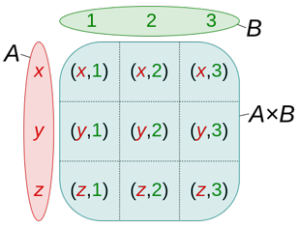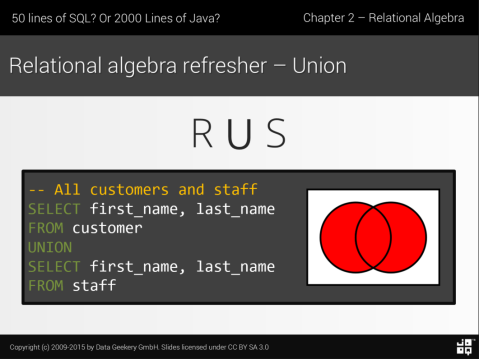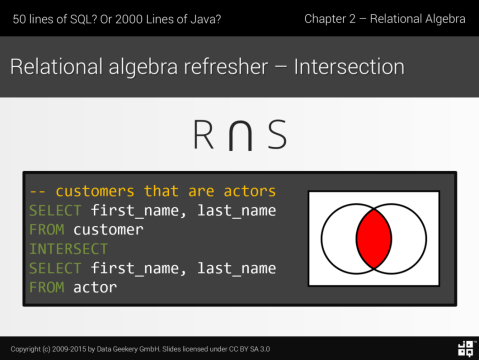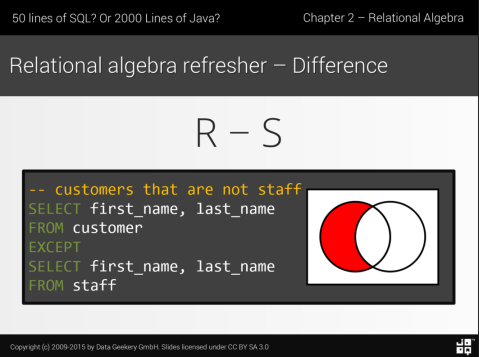You Probably don’t Use SQL INTERSECT or EXCEPT Often Enough
When people talk about SQL JOIN, they often use Venn Diagrams to illustrate inclusion and exclusion of the two joined sets: 
While these Venn diagrams are certainly useful to understand (and remember) SQL JOIN syntax, they’re not entirely accurate, because SQL JOIN is a special type of a cartesian product, the CROSS JOIN.

In a cartesian product between two sets A and B, the result is the multiplication of each set, meaning that each element a ∈ A is combined with each element b ∈ B to form a set of tuples (a, b).
Ordinary SQL JOINs do precisely this. When you join BOOK to AUTHOR, you will probably get a combination of every author ∈ AUTHOR with each book ∈ BOOK, such that for each combination (author, book), the author actually wrote the book.
The true meaning of Venn diagrams
The true meaning of Venn diagrams is much better described by the operations
UNIONINTERSECTEXCEPT(orMINUSin Oracle)
In the following sections, we’ll see that these operations match exactly the semantics of operations that can be illustrated by Venn diagrams, even if you will be able to “abuse” JOIN operations to achieve the same result.
UNION
The UNION operation is the most well-known among these set operations. It is often also referred to as “concatenation” of two sets of tuples, where the result is the concatenation of a set B to a set A.
In the following example, we’ll see that we might be interested in all the different people from our database, given their first and last names, regardless if they’re customer or staff:
The original Venn diagrams used FULL OUTER JOIN to model the “same” concept, although the two things are not strictly same. Consider the following query, which we’ll run against the Sakila database:
SELECT first_name, last_name FROM customer UNION SELECT first_name, last_name FROM staff ORDER BY 1, 2
The result looks like:
first_name last_name ------------------------------------ AARON SELBY ADAM GOOCH ADRIAN CLARY AGNES BISHOP ALAN KAHN ALBERT CROUSE ALBERTO HENNING ALEX GRESHAM ALEXANDER FENNELL ALFRED CASILLAS ALFREDO MCADAMS ALICE STEWART ALICIA MILLS ...
Now, run the following “equivalent” query:
SELECT first_name, last_name FROM customer FULL OUTER JOIN staff USING (first_name, last_name) ORDER BY 1, 2
The result will again yield:
first_name last_name ------------------------------------ AARON SELBY ADAM GOOCH ADRIAN CLARY AGNES BISHOP ALAN KAHN ALBERT CROUSE ALBERTO HENNING ...
This only works because we’re using the USING clause, which not every database supports natively. If we did our JOIN with the more commonly used ON clause, we’d have to write the more tedious:
SELECT COALESCE(c.first_name, s.first_name) AS first_name, COALESCE(c.last_name, s.last_name) AS last_name FROM customer c FULL OUTER JOIN staff s ON (c.first_name, c.last_name) = (s.first_name, s.last_name) ORDER BY 1, 2
In this case, most people probably default to using UNION already, as it is a much better known operation than FULL OUTER JOIN.
All of jOOQ’s currently supported RDBMS support UNION and UNION ALL (the latter doesn’t remove duplicates).
In the following, we’ll see that equivalent comparisons can be made with other set operations:
INTERSECT
The INTERSECT operation is really useful when you want to keep only those tuples that are present in both sets that are combined using INTERSECT:
As you can see, we may want to retain only those customers that are also actors. Let’s run this query:
SELECT first_name, last_name FROM customer INTERSECT SELECT first_name, last_name FROM actor
first_name last_name ------------------------------------ JENNIFER DAVIS
One of our customers is also an actor. The same query could have been written with an INNER JOIN as such:
SELECT first_name, last_name FROM customer INNER JOIN actor USING (first_name, last_name)
… or with the ON syntax
SELECT c.first_name, c.last_name FROM customer c INNER JOIN actor a ON (c.first_name, c.last_name) = (a.first_name, a.last_name)
This time, no COALESCE is needed, as INNER JOIN retains only those tuples from the cartesian product, which are present on “both sides” of the JOIN, so we can pick any of the tables to prefix our columns.
You may even decide to use a semi-join instead, which would yield the same results:
SELECT first_name, last_name FROM customer WHERE (first_name, last_name) IN ( SELECT first_name, last_name FROM actor )
or, using the more verbose, yet equivalent EXISTS predicate:
SELECT first_name, last_name
FROM customer c
WHERE EXISTS (
SELECT 1
FROM actor a
WHERE (c.first_name, c.last_name)
= (a.first_name, a.last_name)
)All of the above, again, yield:
first_name last_name ------------------------------------ JENNIFER DAVIS
EXCEPT
The EXCEPT operation is useful when you want to keep only those tuples that are present in one set, but not in another:
Running this query:
SELECT first_name, last_name FROM customer EXCEPT SELECT first_name, last_name FROM staff ORDER BY 1, 2
… will yield:
first_name last_name ------------------------------------ AARON SELBY ADAM GOOCH ADRIAN CLARY AGNES BISHOP ALAN KAHN ALBERT CROUSE ALBERTO HENNING ...
According to the original Venn diagrams, this can be tweaked using LEFT JOIN and a IS NULL predicate:
SELECT first_name, last_name FROM customer LEFT JOIN staff USING (first_name, last_name) WHERE staff_id IS NULL ORDER BY 1, 2
or with an ON clause:
SELECT c.first_name, c.last_name FROM customer c LEFT JOIN staff s ON (c.first_name, c.last_name) = (s.first_name, s.last_name) WHERE staff_id IS NULL ORDER BY 1, 2
This is completely unreadable and doesn’t communicate the fact that we’re removing tuples from a set CUSTOMER, given their presence in another set STAFF.
An equivalent version using anti-join might be more readable (watch out for NULLs in NOT IN predicates, though!):
SELECT c.first_name, c.last_name FROM customer c WHERE (first_name, last_name) NOT IN ( SELECT first_name, last_name FROM staff ) ORDER BY 1, 2
… or, using NOT EXISTS:
SELECT c.first_name, c.last_name
FROM customer c
WHERE NOT EXISTS (
SELECT 1
FROM staff s
WHERE (c.first_name, c.last_name)
= (s.first_name, s.last_name)
)
ORDER BY 1, 2Conclusion
UNION, INTERSECT, and EXCEPT are very simple, yet very useful operations that can add a lot of value every now and then in your daily SQL tasks. While JOIN operations are much more versatile, they are also more complex for the simple tasks that can be solved by UNION, INTERSECT, and EXCEPT
| Reference: | You Probably don’t Use SQL INTERSECT or EXCEPT Often Enough from our JCG partner Lukas Eder at the JAVA, SQL, AND JOOQ blog. |







